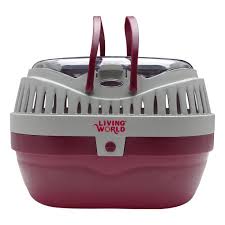This article about pet rats you will find:
- Rats as pets and how many should you keep.
- ideal pet rat cages and set up ideas.
- toys and enrichment with hides, hammocks, chew toys and tunnels
- Diet for pet rats and what not to feed.
- mineral supplements and vitamins
- set up check list.
- training pet rats
- best substrate for rats
- parasite control
- health issues
- History of domestic rats.
- information on our pet pats for sale.
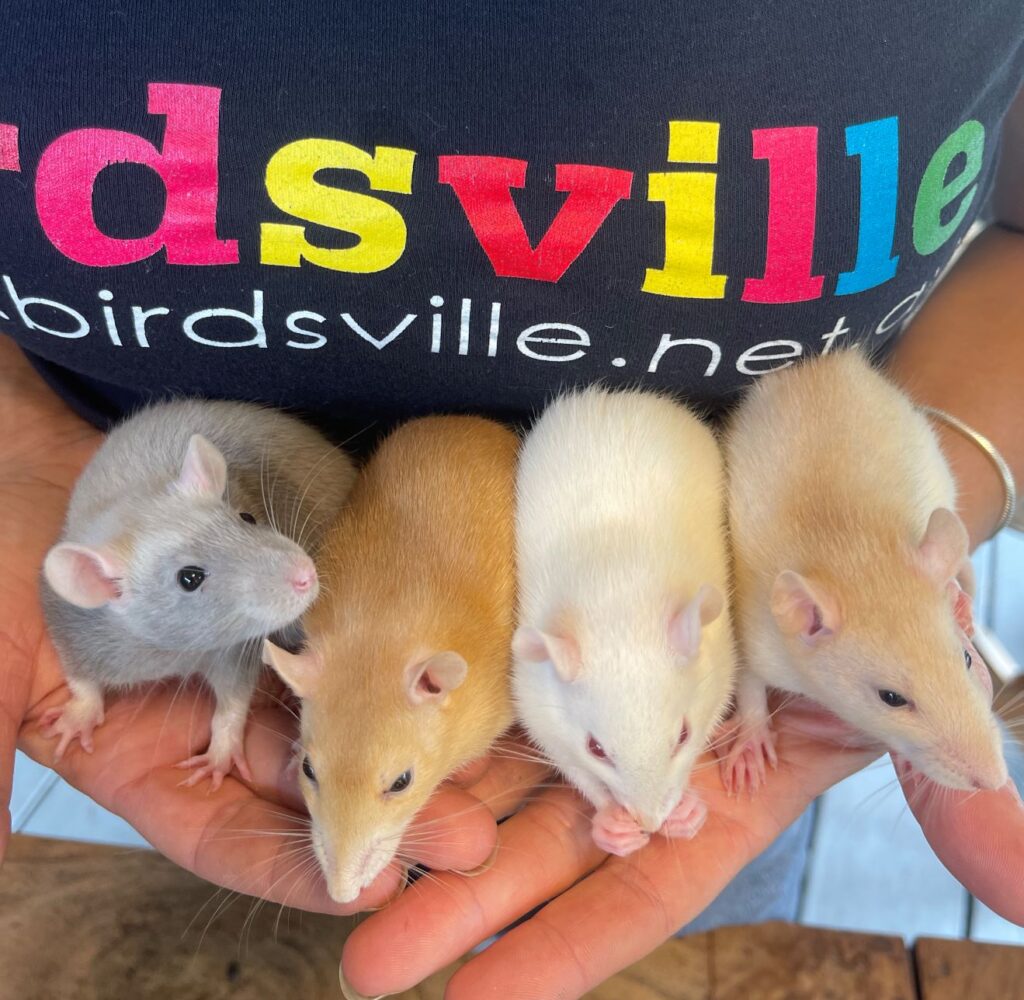
Rat Breeder Sydney
Everything you need to know on pet rats as pets to keep them happy and healthy and also what to look out for. If rats are not bred correctly or provided the righ conditions, they are susceptible to an increased chance of health conditions. Rats should have a varied and good quality diet. We will cover all the details on how we recommend caring for our pet rats for sale.
Pet rats are incredibly intelligent and will bond closely with their owners. Their average lifespan is 2-3 years. To maintain good behavior frequent handling in important, your rats will enjoy a face massaged. They do not have good eyesight but have an excellent sense of smell and hearing. Pet Rats are extremely social, so consider getting more than one.
With a full range of pet rat enclosures and products ask us about our full set up specials in store only. We have been improving the health of pet rats in Sydney for many years.
Visit our Facebook and Instagram page for helpful tip, advice and for updated photos of our rats currently instore.
https://www.facebook.com/BirdsvilleRosebery/
Owning a pet Rat
While many people will cringe at the thought of having pet rats, believe it or not, domestic rats do make great pets! They are not aggressive, not diseased and clean animals. Pet rats are in-fact clean, fun-loving, sensitive, very social and affectionate. Regular handling in important, as rats genuinely enjoy interacting with their owners.
Pet rats have an amazing intelligence and with time and patients we can teach them simple tricks, such as stay, sit and to come to their name.
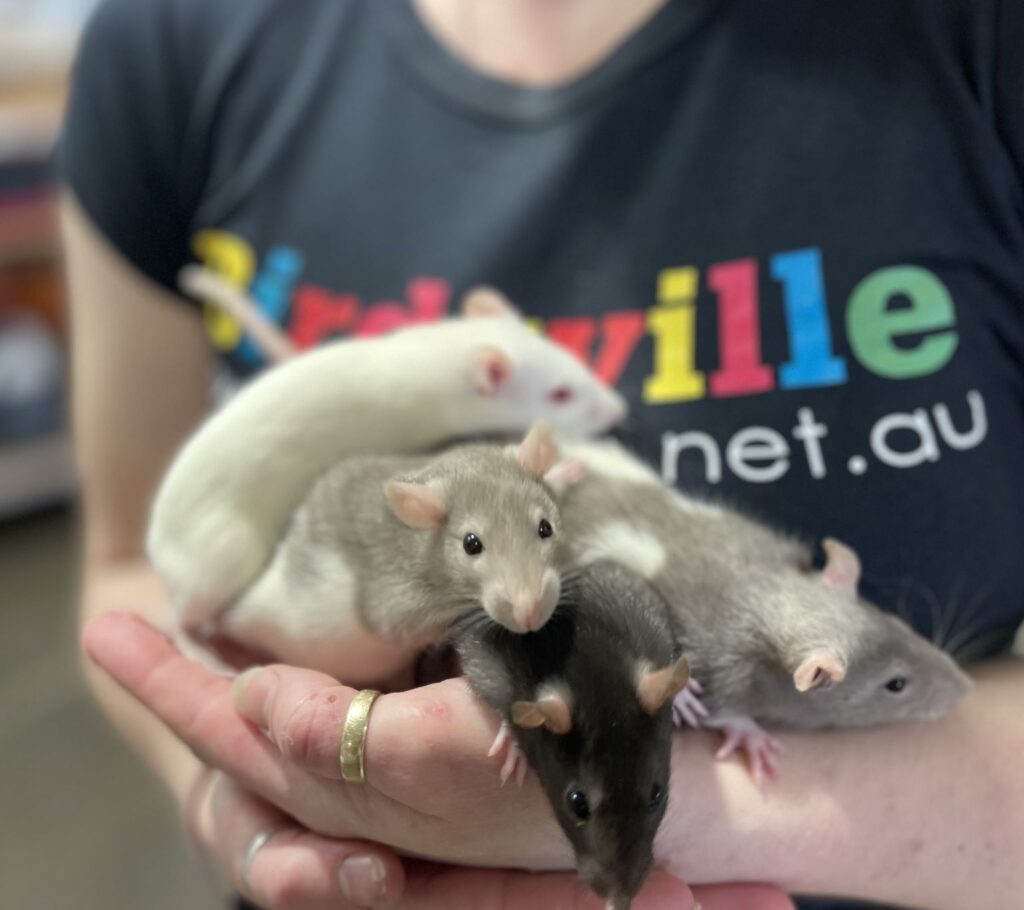
Pet rats will often develop a connection with their owner and want daily attention. They also enjoy playing and snuggling with their owners.
Pet rats that are well handled are very friendly toward humans and very rarely bite. Children should be taught not to stick their fingers in the cage if their hands smell like food. Even the friendliest rat may be tempted to take a taste.
Pet rats require time, interaction and upkeep. Because rats are very social animals, they can get bored easily and it is a good idea to have lots of toys. We suggest keeping the in pairs as they are very social creatures.
One or two rats
Having two rats is no more work than having only one and they can live in the same cage. Two rats will be entertaining to watch and will take some of the stress off of you in having to entertain them. Yes, pet rats love to play. Rats are social and love company.
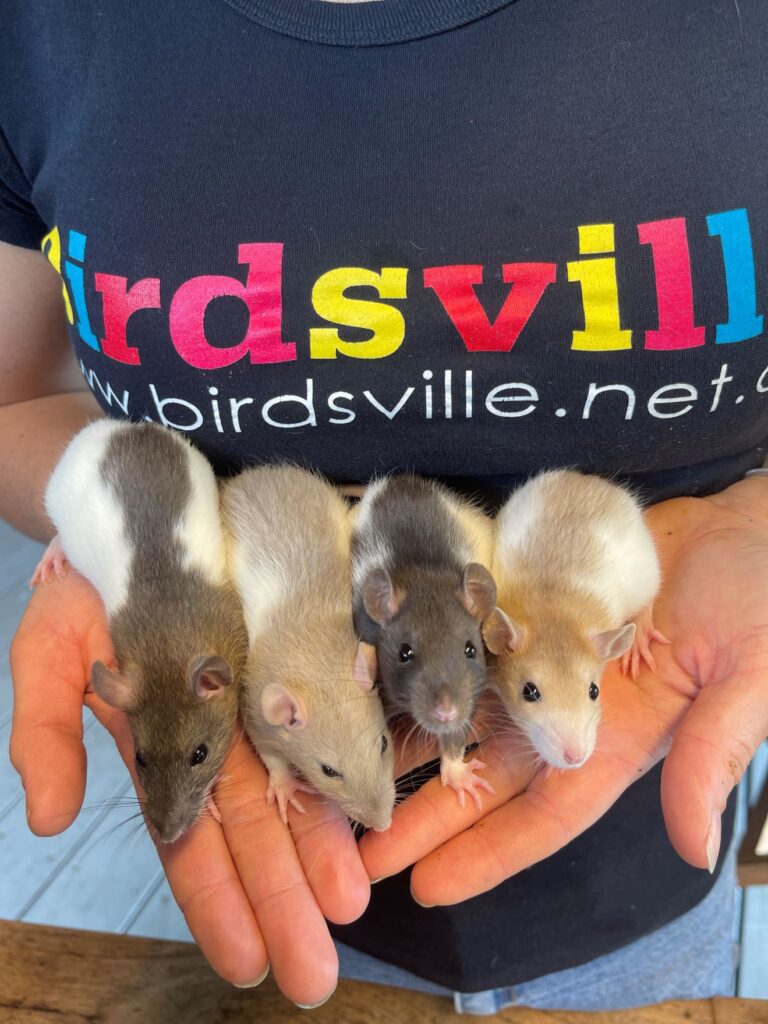
If you keep more than one rat, be sure to either have two males or two females or get your rats spayed and neutered by a vet to avoid any unwanted breeding. Your local vet can de-sex your rats.
However, if in an unlikely situation your rat is overly aggressive with other pet rats you may have to keep it all by itself. When you purchase your rat be sure the place you obtain your rat from keeps males and females separated. Especially since a rat can get pregnant at the young age of 6 weeks old. At Birdsville we do keep our males and females in separate enclosures OfCourse.
Our Pesville Birdsville team members are only human so we can rarely find some young pet rats difficult to sex. So, we do our best to make sure you don’t purchase a pregnant rat and end up with more rats than you planned for!
Baby Rats for Sale Sydney
Petsville baby pet rats for sale have not just been bred for color and temperament but have had different blood lines from around Australia to produce a stronger healthier animal. Our rats are not inbred and have a high genetic diversity as we regularly source new bloodlines. This is the reason why we do not have patchwork rats as they have many genetic problems.
We do not breed from any rats that have any health issues. With a lifespan averaging 2 years like all domestic rats, but hopefully fingers crossed, breed out or reduce some of the common respiratory conditions and cancers. This is explained a bit more below.
Our pet rats are also raised on Vetafarm Origin Rat pellets, our Petsville Rat pellet blend with healthy legumes, fruits, seeds, vegetables. Young pups raised on a quality diet are less prone to rat respiratory lung disease and thus should be healthier animals. As all rats carry this virus its unfortunately common for them to have wheeziness come and go. Our animals have a health warranty period on purchase.
Rat cage and enclosures
Pet rats get bigger than people think, and they need sufficient room to move around as you will also want to place inside the enclosure a variety of toys, food bowl, drink bottle, salt lick, hammocks, places to sleep and tunnels etc. We a huge range of different styled enclosures. We also have specials when you purchase a rat with a complete set up. Keep in mind the bar spacing, baby rats can squeeze through the bars of some large, wired cages that was designed for adult rats. If you are unsure, you can test the wires with out of our baby rats in store.
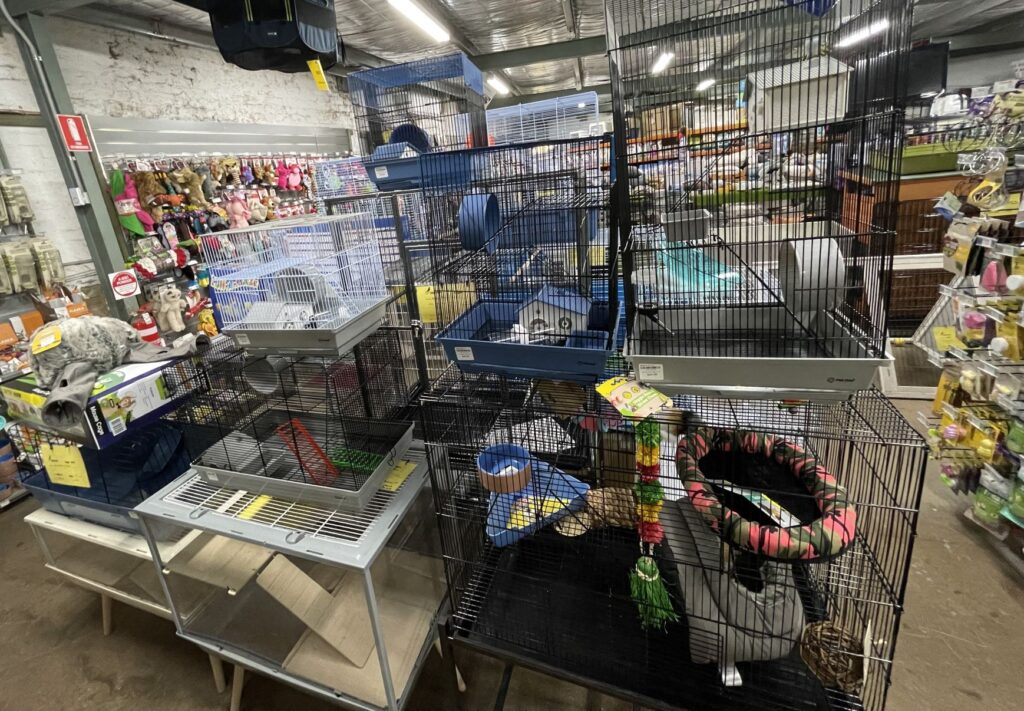
Enclosure set up
The average minimum pet rats enclosure size we recommend is around 60cm x 42cm x 61cm high. There is no such thing as a cage that’s too big, at Petsville we do have a lot of different enclosures to choose from on our mezzanine level. With any enclosure take into account the size of the wire as baby rats can escape through large, wired cages.

Pet rats love to climb so choosing a cage with levels is ideal, It’s best to deck the cage out thinking of those levels, on the top level have some hanging toys, hammock, a hide on the middle level place some wooden bird perches, drink bottle, salt lick and maybe a bird ladder and on the bottom have some tunnels to run though, food bowls, chew toys, birdy balls and a rat wheel.
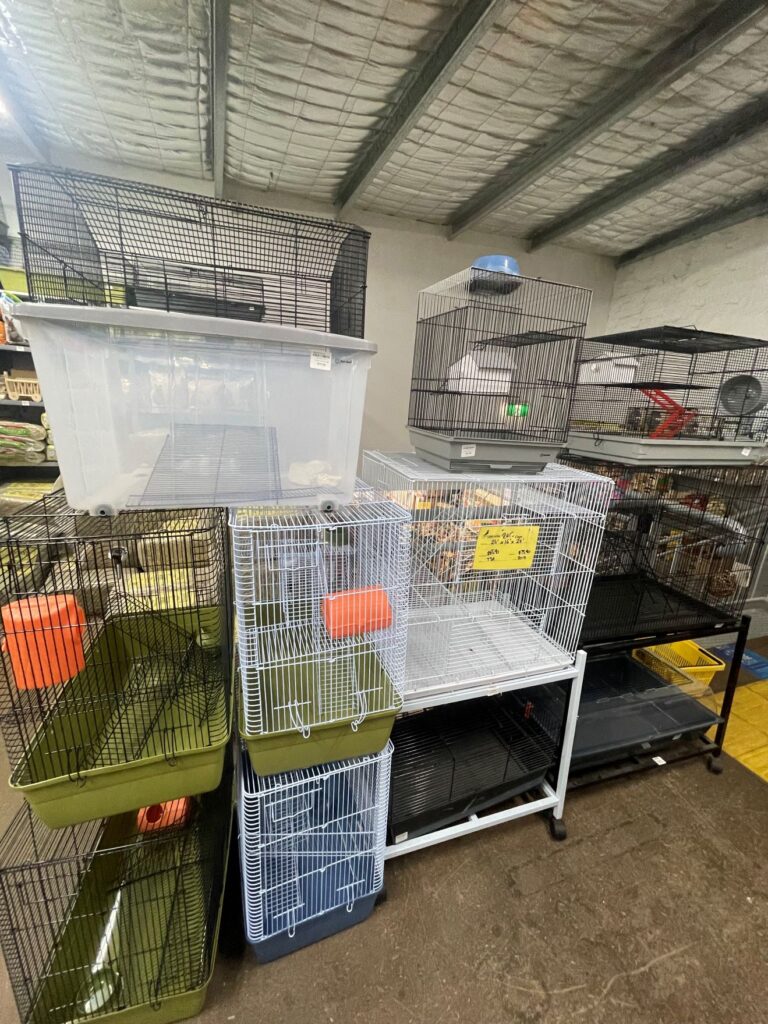
Pet rats need a hide in the enclosure for them to feel safe as they like enclosed areas. Nesting material is great as they will build a nest with it. Rat toys and chews are essential to keep the teeth warn down and yes Rats like to play with them. Attach a saltlick to the side and if your cage has space you may like to add a rat wheel for them to exercise.
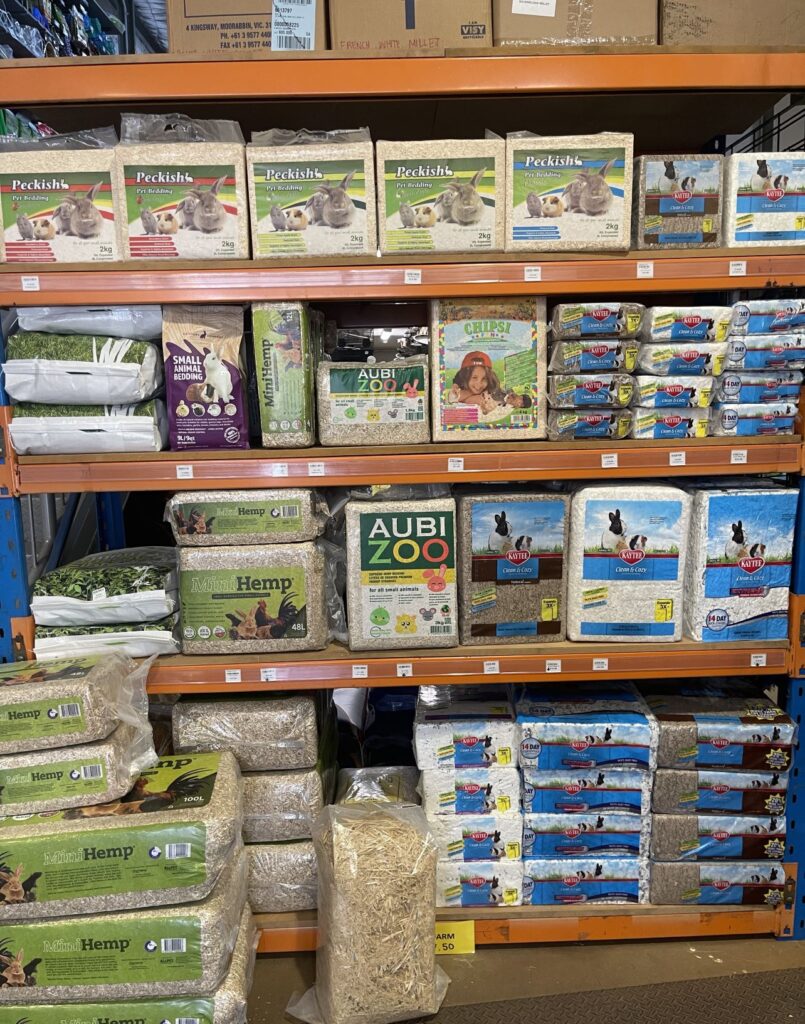
Substrate and bedding for rats
Pet rats can be susceptible to respiratory conditions and that’s why we recommend hemp, Kaytee bedding or breeders’ choice which are dust free and very absorbent. Bedding depth can be around 5 to 15 CMS, the thicker the bedding the less often it needs to be changed. This is also dependent on the enclosure you choose as well.

Toys for rats
Both male and female pet rats love to have toys and play. Toys and accessories must be provided and available at Birdsville aka Petsville. Your pet rat will love toys such as tubes, hammocks, fruit tree branches, rat wheels, bird ladders, rat balls, guinea pig and rabbit toys, gum tree branches, hanging bird toys, paper towel rolls, toilet paper rolls, plant pots and anything else that does not have a sharp edge that can be provided for your rat’s enjoyment. Keep in mind that they will chew what you give them. We supply a huge range of rat cages in store at discounted prices.
Environmental enrichment (toys) keeps your pet rats entertained while you are away and while they are in their enclosure. It also helps prevent behavioral issue down the track, such as chewing and general psychological disorders or depression. It will help creates a tamer, friendlier and happier rat. Toys need to be rotated regularly so he or she doesn’t get bored and if the rat destroys the toy, it means they like it and should be replaced.
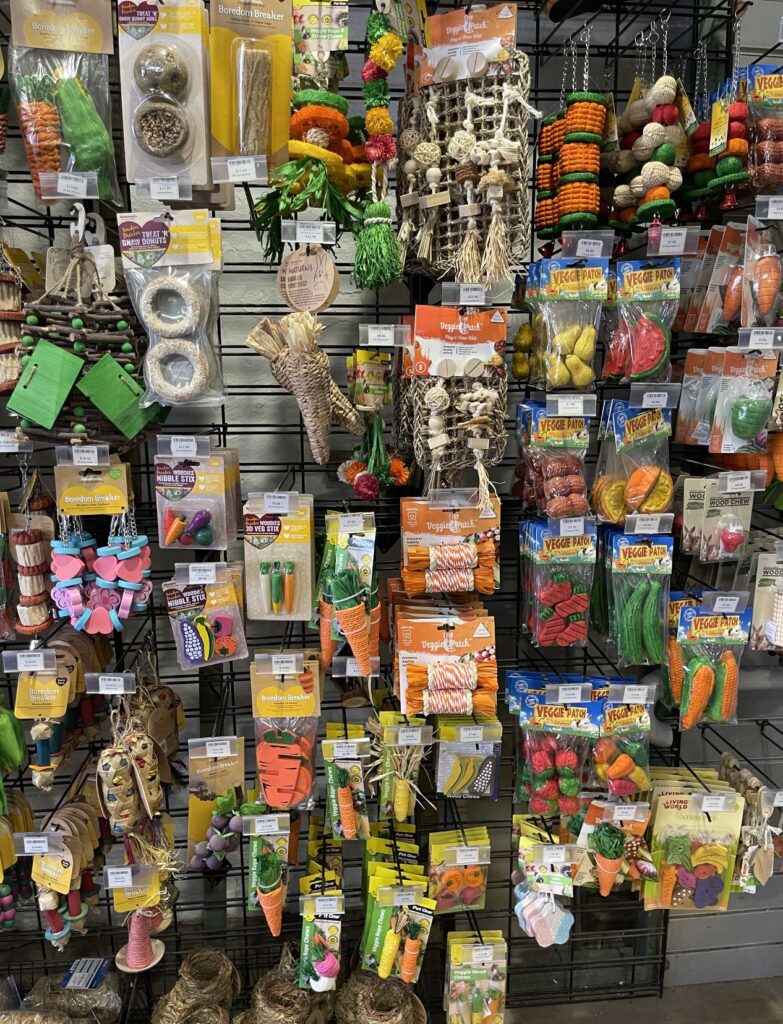
Pet rats also enjoy balls and soft toys to chew or pull apart. Be sure to always keep their toys cleaned and replace any broken ones. Rats love to play with and chew toys, hanging toys, ball toys Rats also love many bird toys. We have such a large part of our store designated to just Rat toys for a reason as they just want to have fun. Toys also help to keep their teeth trim, which is very important, without toys it’s a matter of time before the teeth over grow and result in very expensive vet bills.
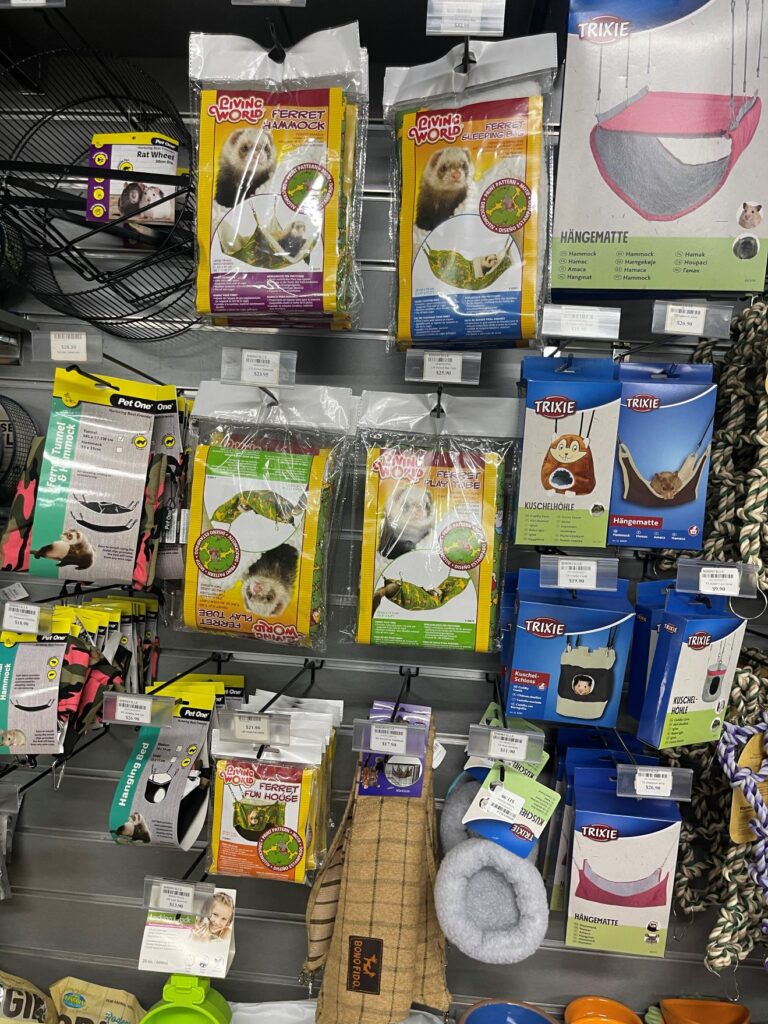
Rat Hides, Hammocks and Tunnels
When choosing a hide make sure the rat can fit inside as they grow, as animals that love to hide to feel safe, they do like to feel snug. It is important to supply animal bedding, they use to make a nest to sleep in.
They also love to scurry through tunnels, we have a wide variety of wooden and plastic hides, some hides are hanging we prefer the wooden as it’s an extra item to chew on, this is the same for our plastic or woven hides. Hammocks are loved by rats to play in and to make nests. Rats like often like to build more than one sleeping area.
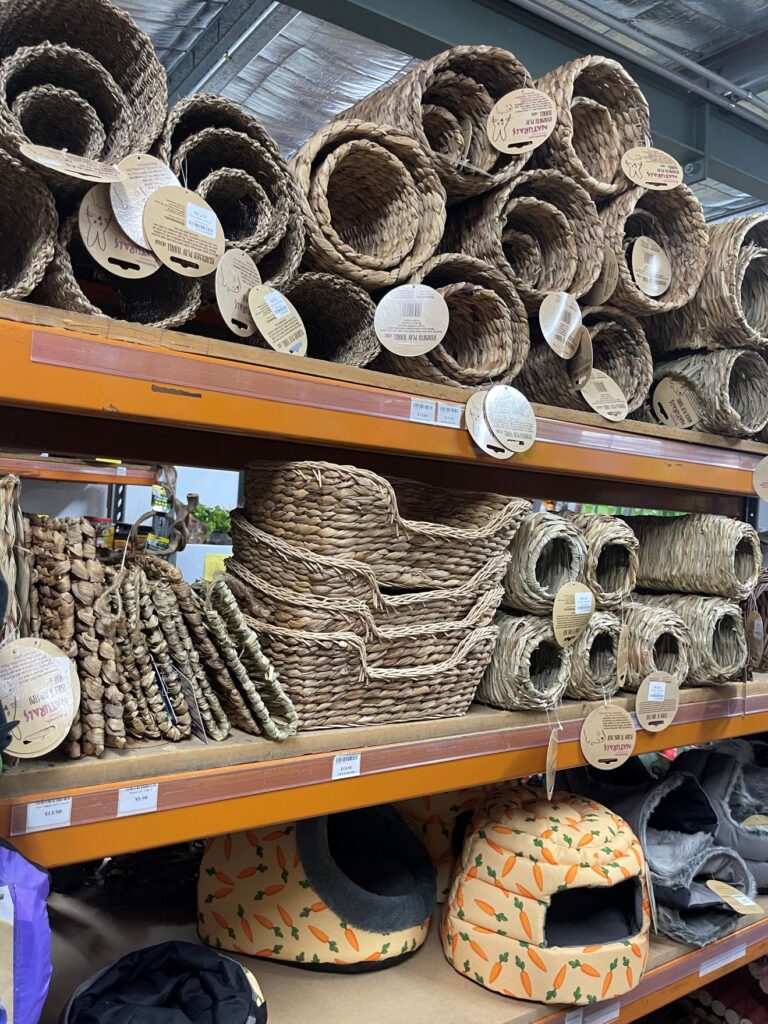
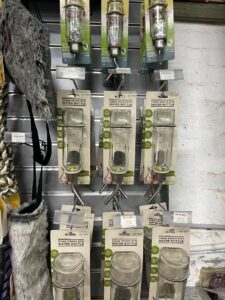
Diet for pet Rats
A proper diet is important for your pet rat’s good health. Rats are omnivorous, which means they eat both plant and animal material. They love food in general and will eat almost anything you put in front of them, savoring every morsel.
Pet rats love junk food just like us. Try to keep their diet as healthy as possible. Stay away from sugar. There are many healthy treats that you can offer your rats. Hopefully we can give you some ideas on how to add some variety in their diet, while keeping them healthy at the same time.
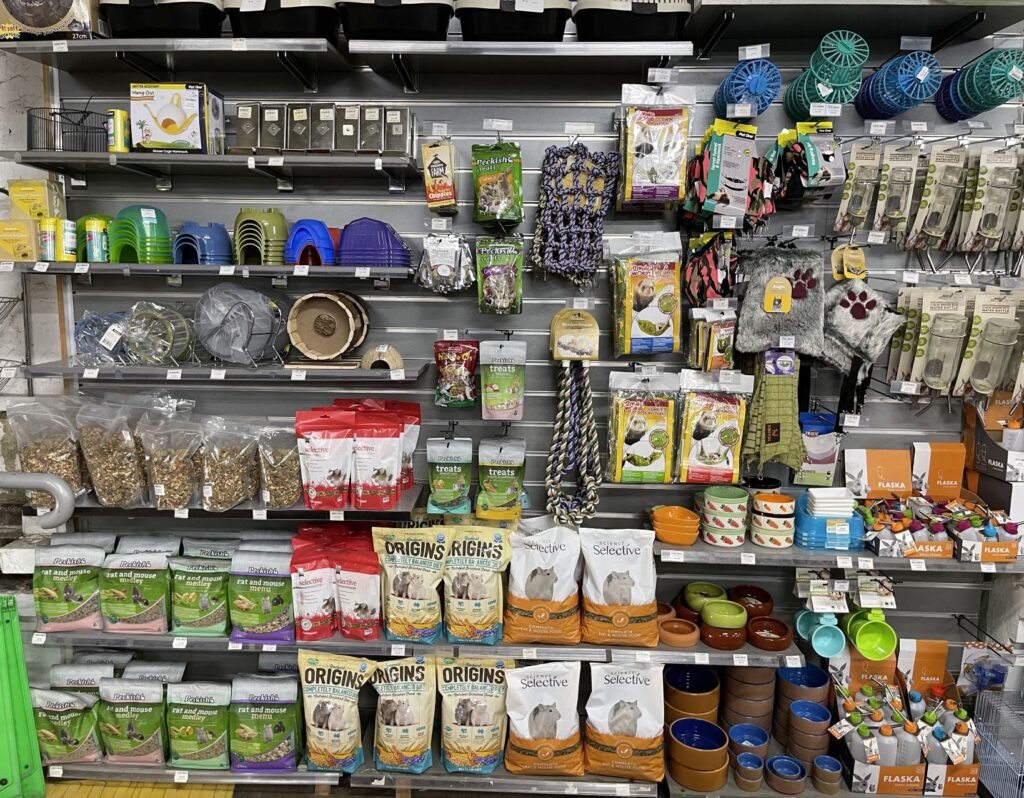
Choosing the right Diet
Many commercial pet rat foods are unhealthy and should not be fed to rats. They may contain harmful additives, waste foods and chemical preservatives. Some contain (whole kernels of) * corn that could even contain fungus and mold, tiny seeds and also alfalfa pellets which are hard for rats to digest, and they usually don’t care for it any way.
Vetafarm Rodent Origins , peckish rat pellets and selective rat pellets are all quality brands that we use and stock. All formulated by expert nutritionists and vets, Contains a specific blend of vitamins, minerals and amino acids for long-term health and general vitality. Fruit flavored and extrusion cooked for increased palatability and digestibility.
One of the best rat blends that a pet rat can get, is our Petsville Blend, which in mix in store. We add rat pellets with a mix of vegetables, meat biscuits, legumes, grains and fruit. We have this available in our rat area upstairs and is very popular.
What percentage should you feed Pet rats
The quality pellets are recommended to make up 90% of their diet along with treats, fruit, and vegetables adding the 10%.
If you do decide to use a low-quality brand, we recommend supplementing your rats’ water with Small Animal Vitamins to make sure they are getting the essential vitamins they need.
The additional 10% of your their diet should consist of the following items – Petsville Rat treats, carrots, apples, watermelons, blue berries, strawberries, pears, apricots, oatmeal, chicken + bones, beef, rice.
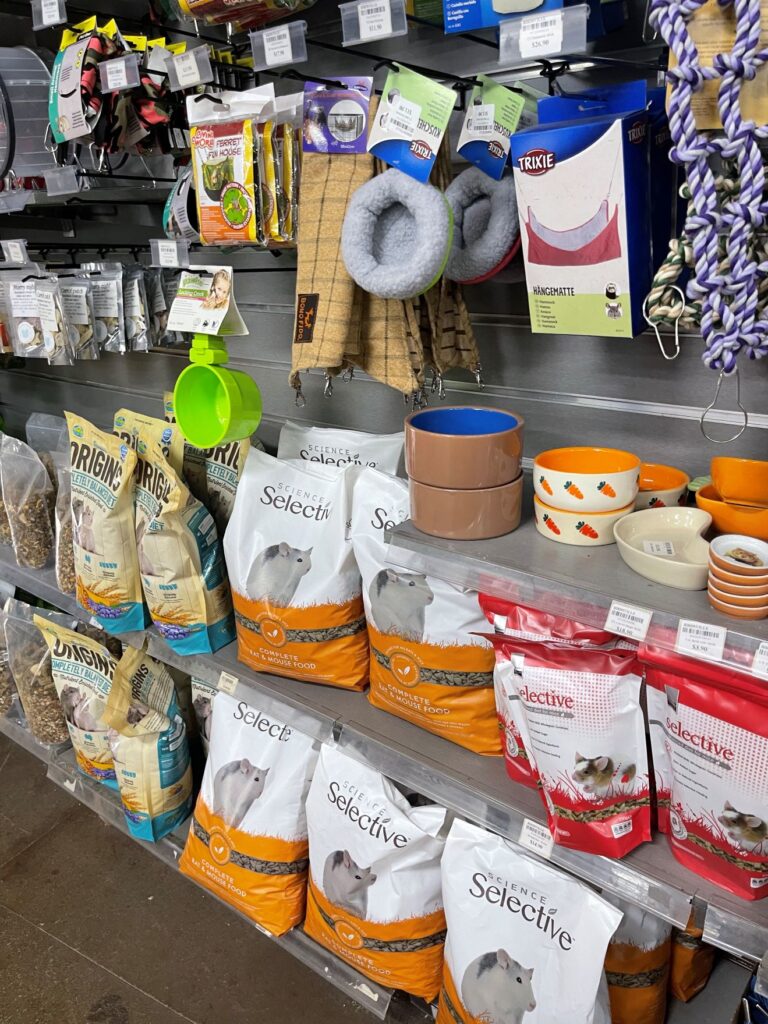
Good-quality food and fresh, clean water must be readily available at all times.
Your pet rat’s dry food can be hung in a food dispenser or put in a heavy ceramic dish that won’t tip over. This prevents little opportunity for fecal (stool) and urine contamination of food.
Food consumption varies with the quality of the food offered, the age, health and breeding status of the individual, the environmental temperature, and the time of day. Pet rats tend to eat more at night, but daytime feeding is also common.

Fresh vegetables for Pet rats include but are not limited to: Squash, Mustard greens, Collard greens, Romaine, Lettuce, Spinach, Cucumber, Alfalfa sprouts, Zucchini, Pumpkin, Asparagus, Broccoli, Cauliflower, Brussel sprouts, Carrots, Celery, Fennel, Sweet potato raw.
Occasional treats: Rice cakes, Cheese, Baby food, Mixed baby cereal, Chicken bones, Dog biscuits, Soya milk, Fish sticks, cooked rice and pasta, cooked pasta and rice
Whole protein sources: Chicken, Beef, Tuna, Salmon, Oysters ‘Shrimp, Liver
What not to feed Rats
- Too much cheese – use a tiny bit as a treat.
- Too much peanut butter – can cause a rat to choke, and they cannot vomit.
- Dried corn – can cause liver cancer.
- Iceberg lettuce – full of water and has no nutritional value.
- Orange juice or orange peel
- Blue cheese dressing – toxic
- Licorice
- Rhubarb
- Red cabbage – causes gas
- Artichokes – causes gas
- Raw banana
- Potato skins
- Green or starchy potatoes – not ripe all the way
- Poppy seeds – cause neurological damage and sometimes death.
- “Junk foods” – chips, and fast-food products and beware of buffet foods with preservatives in them.
- Excessive candy and/or chocolate – one chocolate chip, for instance, is fine and often acts as a bronchodilator which helps pet rats with respiratory problems.
Fresh water
Having fresh water available daily is very important, as many pet rats presented as “sick” could actually be de hydrated.
Fresh water must always be made available for pet rats and kept free from contamination by providing it in water bottles available in store at Birdsville. We supply both glass and plastic bottles of different sizes. These are perfect as they last longer, and the rats are unable to poo in them.

Salt licks, mineral licks for rats
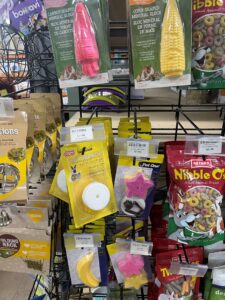
Your pet rats may need minerals depending on the diet. There is no sign to tell if your rat needs salt. Different quality produce and diets can simply lack a high enough salt content. The salt content depending on where the produce is grown.
Salt and minerals are necessary for a rat’s diet, but it must be consumed in moderation. Which luckily your rats will instinctively know when its body needs additional salt. A salt lick is important as it will aid in digestion, muscles, nerves and fluid regulation.
Vitamin Supplements for pet rats
To add that extra bit of health and vitality, Petsville stock small animal vitamin supplements drop that contain concentrated multivitamin, vitamin c and iron source. These supplements keep up their vitamin and mineral levels to keep your Rat in top healthy condition.
Worming pet Rats
Rats are very susceptible to worms, as they naturally explore new objects with their mouths. Baby rats should be wormed 10 days after bringing them home. An adult rat you can worm straight away, even if it has already been wormed just to be safe.
Indoor rats should be wormed every 3 months and outdoor rats should be wormed every 6 weeks. Baby Rats should not be wormed until they have settled into the new environment (after the first 10 days). If you worm a pet rat too young or to soon after being moved to a new environment can upset its stomach.
The common house fly is known to spread a large number of parasitic worms. This happens when the infected fly that has left a pigeon poo or any poo for that matter then flies through the window and lands on your rats’ water, food bowl or on your rat and infects them. This is the reason why regularly worming need to happen.
Humans and other pets can get the same worms, especially when handling an animal. Worming your rat does not only protect them, but also the whole family.
Worming your rat is easy, as the solution goes into your rats drinking water. The worming bottle comes with easy-to-use instructions on the label.
Mite and mange spray for Rats
Pet rats are very susceptible to mites & mange. Spraying your animal with lice & mange spray every 12 weeks as a preventative will ensure you don’t have a problem.Lice and mite spray is simply sprayed evenly on the animal avoiding the eyes, the bottle has easy to use instructions on the label.
Lice & mange can be easily transmitted by the common house fly.
Rat Setup/Everything you will need:
Carry Cage – every rat owner needs one for safe animal transport.
Enclosure/cage – make sure wire is suitable for age and size of rat. Minimum rat size cage recommendation is 60cm x 42cm x 61cm high.
Quality Rat Pellets Mix– Petsville Premium Rat food, Selective, Peckish, Rabbit Origins, Birdsville Small Animal
Salt Lick / Mineral Block – provides essential salts and minerals, including calcium to assist with healthy teeth, digestion, and healthy bones.
Treats – great for training and rewarding your pet.
Drink bottles – important, as your rat can’t poo in it or be tipped over during the day.
Bowls – a place to put your rats all you can eat buffet into.
Toys – hanging toys, chew toys and tunnels. Bird toys are great for rats, like ladders, bird toys, balls and perches. Minimum 4 appropriate toys for chewing and playing.
Tent/ Hide – small safe place for your rat to hide. Can range from tents, pouches, and hides which come in a variety of materials and sizes. When choosing one, keep in mind how big your rat will grow too.
Substrate – paper litter, mini help, oz hemp wood litter or Kaytee litter.
Hutch Cleaner – CSI, Vetafarm, F10 and Aristopet are all rat safe, nontoxic disinfectant and makes it easier to remove poo and dirt from hutch, toys, and bowl. Normal disinfects can be quite toxic to rabbits.
Wormer – recommended to worm 1 week after bringing home and repeated every 3 months to prevent internal parasites.
Lice & Mange Spray – recommended to use 1 weeks after bringing your rat home and repeated every 3 months to prevent external parasites.
What you may like to consider:
Feeding / Accessories – Spare treats and bowls for food and water.
Vitamins – Small Animal Vitamins
Rat shampoo – small animal shampoo for bathing your rat, we stock small animal shampoo.
Bed – for the luxurious rat who likes comfort.
Tunnels – great for rats to run through and play.
Synbiotic / Probiotic – can boost immune system, support digestive function when use daily. Also, can help Respiratory Rat Disease.
First aid – Spark, Triple C, F10 barrier ointment and heat lights are a few things that can be kept on hand in case of an emergency.
Harness – recommended if you want to take your rat for adventures.
Toilet – toilet training you will need an appropriate size litter tray and wood or paper litter. Substrate in litter tray should be different from substrate used in the enclosure.
Rat Enclosure Hygiene
Rats live in such close contact with their litter and bedding these must be kept clean and free from toxins. Cleaning your rat’s cage regularly, with the right cage cleaner, is essential to avoiding unnecessary health problems.
Ammonia in the fumes of urine can causes irritation in the nasal passage which makes them more susceptible to infection.
If your cage gets smells more than normal for a rat cage, you have left it too long between cleans. You can usually tell when the enclosure needs changing because of the smell, or the bedding becomes damp.
Training Pet Rats
While handling rats always support their bottom and hold them with 2 hands.
When you first bring your ratty home, it is a stressful period for them. Give them a day or two to get use to their new environment. When your Rat has started to eat and drink, you can start to handle them.
Gently handle regularly, in short intervals, and give them plenty of rest time. Rats can jump, but it’s important that they are not dropped. Dropping could cause severe injury.
If your baby pet rat gets spooked, they will become jumpy. This can be easily fixed with patience, don’t be afraid, and sit somewhere quiet patting them. They will start to bond with you.
Rats in a new cage can be a bit standoffish. It’s important to do plenty of gentle handling to get them used to you and your scent and relax.
Understanding sight, touch and smell
Understanding sight, touch and smell is essential before training. When you understand the right approach, you can train them quite easily.
Firstly, you need to understand how a pet rat views and smells the world. As a prey animal rats have eyes on the side of their head, seeing almost 360 degrees. Rats have very poor eyesight but can see movement very well.
A Rats sense of smell and whiskers are used to detect anything in its immediate environment more so than sight. Before touching or patting your rat, you need to calmly let them see and smell you. This greatly improves your bonding, allowing your rat to be calm, as this will verify that you are a friend and not a predator.
Once you have been verified, give your rat a favorite treat and give plenty of kisses and cuddles, as they love affection once they feel safe.
Devoting a little time every day to training your rat will get best results. 2 sessions a day for at least 2 minutes followed using your rats’ favorite treats.
Petsville have a huge selection of rat treats. When you call your rat, give them a reward every time they come to you. Always make sure you give your rat has a treat immediately, when he has performed what was asked.
Harness training Pet rats
First thing you will need is a proper harness specifically for Rats. Petsville have a number of good quality rat harnesses and leash’s arriving regularly. Never use a collar on a Rat.
Start by getting your rat used to wearing the harness and leash inside. Begin with for a few minutes at a time to get them use to it. start leaving it on for longer, then introduce them to the leash indoors.
Never rush your rat and have realistic expectations. Don’t make the walks too long or daily. Just the occasional excursion to a nice area when they are used to the leash and harness.
Toilet training your Pet rats
Using a suitable plastic litter tray available at Petsville, you will need to use a litter or bedding different to the kind used for the base of the enclosure preferably highly absorbent, good for odor control and not scented.
Fill the base of the tray with about 3 to 4 CMS deep of your chosen litter. Observe your rats and place the litter tray in the area the rats defecate the most. Pick up droppings from around enclosure and place in litter tray.
It is likely that your rats after a few weeks will start to use the litter tray. You can encourage by giving your rats a treat when you see them go to the bathroom in the right spot. Be patient every rat is different; it can take some time.
Litter trays do not need to be cleaned daily; they can be left as long as a week before cleansing.
History of domestic rats
The Domestic Rats Latin name is Rattus norvegicus. The domestic rat now comes in lots of colors, but was once a wild brown animal living wild in southern Asia.
This animal found plenty of food and shelter close to people. By 1340, they had become a pest to all habitable areas by sailing ships. This rodent was not a welcome visitor and arrived in Europe in 1346.
By 1846, people were experimenting with rats in France. Living the easy life in cages, the rat’s genes had mutated. Making the rat more mellow and easy to tame.
In 1906, a white litter was born. The descendants were then sent to America. The white rat’s bloodlines were used to develop new strains and bloodlines.
So, all the domestic rats are descendants from this original bloodline, which makes all domestic suspectable to some viruses and bacteria including mycoplasma or respiratory rat disease.
Health issues or changes in your Rat:
If you ever notice a change in behavior/appearance, off their food, quiet, lethargic, wheezing, runny nose, runny eyes, drooling, skinny.
Respiratory rat disease
Also known as mycoplasma spp. This is by far the most common of diseases in pet rats. It is so common because every single pet rat carries this virus. Not all rats are born equal, and some will come down with RRD even if you do everything right.
This virus can be brought on by a dusty environment. this is why, it is recommended for rats to have dust free bedding. It’s also important to keep their environment clean with regular cleaning.
Signs of this condition are sneezing, weight loss, eye or nose discharge and lethargy. In severe infections open mouth breathing. To reduce the chances of your rats getting this condition, make sure they have dust free bedding and regular cleaning. The enclosure should be well ventilated with wire sides, glass tanks are not advisable.
Cancer/tumors
Cancers and tumors can be quite common in rats, as they originate from rats used to research cancer. They are often fatal without a vet intervention.
Red, Orange or Pink Discharge from eyes and nose
Red, orange or pink discharge coming from eyes and nose, is a condition known as chromodacryorrhea or red tears. It can come about from a pigment in the normal tears of your rat. Small amount of this can be normal and the condition should eventually clean this by itself. However, an increase can indicate an underlying health issue.
Loneliness
Rats can be highly social creature and can die from loneliness, this is why we recommended keeping them in pairs. If you keep a signal rat, time out of the cage, plenty of space to exercise and plenty of toys to entertain themselves.
Bumblefoot
Sores on the bottom of a rat’s feet. This happens when rats kept in a cage that is often unclean with a wire bottom and do not have other sufficient things to walk on. If you do have a cage with a wire bottom simply place some wooden perches, ladders or ramps in it.
If you place the recommended toys, perching and hides, bumble foot should not be a problem. This is not a common condition and to our knowledge haven’t had a customer report this condition yet.
Sudden Death Syndrome
Small animals are more susceptible to sudden death syndrome. Fright, spooked, heart attack, stroke, nightmare or nightfright may all be possible reasons for the occurrence of sudden death syndrome.
Often when an animal passes from sudden death, a full necropsy report from a vet will come back showing no reason why the animal passed. Sudden death can occur with any animal, especially small ones. Unfortunately, one cannot guarantee life of any creature tomorrow, as it is a living being and not a toaster.
Coat dandruff or fur loss
A possible sign your rat has mites or less commonly fleas. A regular mite and lice treatment and a multivitamin should get their coat looking beautiful again.
Weight loss
Overgrown teeth are the main cause of weight loss, but there are a whole host of other reasons, such as, cancer, neurological disease, virus, bacteria, starvation, trauma, stomach ulcers, injury, kidney failure, tumors, dental disease, poisoning, respiratory rat disease to name a few.
Health check
A great skill for any rat owner to have. It can increase your ability in spotting if your rat is not 100%. A Rat visual health check starts with a pat from the head to tail. Your rat is skinny, if you feel the ribs and bones. Check your rats’ eyes, nose and mouth, there should be no discharge or mucus. The eyes should be clear.
We do stock some basic medications. Our team has many years of experience care and handling rats. All team members have been provided training in preform a visual health check, but we are not vets. Below is a list of recommended vets, that can do a whole series of tests and pick up asymptomatic conditions.
Teeth Health
Rats’ teeth grow constantly throughout their lives. Rats need to be fed an appropriate diet and given chewable toys or their teeth will over grow. Overgrown teeth will begin to dig into the sides of their face, making them unable to chew normally. Without proper attention, overgrown teeth can cause serious trauma, anorexia, infections and pain. Even death from the inability to chew and swallow may happen. To drastically reduce the chance of teeth over growing make sure your rat has proper chew toys in the enclosure.
Claws
If you do have a rat with overgrown claws our petsville team offer a nail trimming service
Sexing Rats
Please be aware these animals are not DNA sexed. Whilst we may give an opinion on sex, this is not a guarantee. Young rats can sometimes be hard to sex. we do our best, humanly possible and rarely get it wrong. One of our expert team members are happy to show you how to sex baby rats in store.
If an animal is not your desired sex, we offer no refund, credit or exchanges.
If you have any concerns, or question don’t hesitate to come in store with your rat. We are always happy to help and give advice, even if your rat has come from somewhere other the Petsville.
Are you ready to be a Rat Guardian?
For all new rat owners, please read above. We have detailed all the important non-sugar-coated facts about eat ownership. Please follow these details above, as there are many different opinions online. With incorrect information, sadly the rat can pay the ultimate price. Our goal is for our customers’ rats to thrive physically and mentally.
Rat Boarding
Boarding is available throughout the year, please click the links for information on our rat boarding facility.
Recommended Vets
SASH
Small Animal Specialist
Hospital 02 (9190 6806)
Level 1 1 Richardson place North Ryde
The Wild Vet
1300 9453 838
22A Bridge Road, Glebe
SERV
02 9436 4884
57-63 Herbert St Artarmon
Southern Cross
02 9516 0234
60 Princes Hwy, St Peters
Carlingford Animal Hospital
02 9871 6036
772 Pennant Hills Road Carlingford
995 Bourke Street waterloo Sydney NSW 2017
Vetafarm Manufacture some of the food we supply and can answer any food questions regarding vetafarm products.

